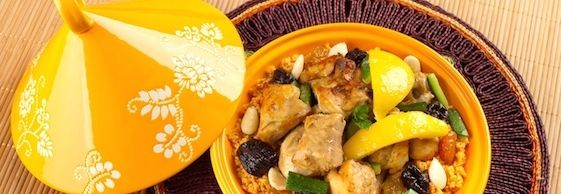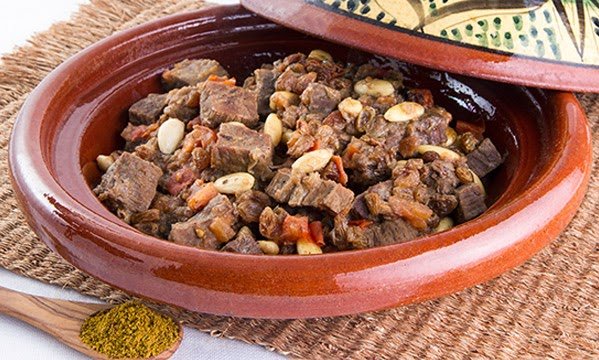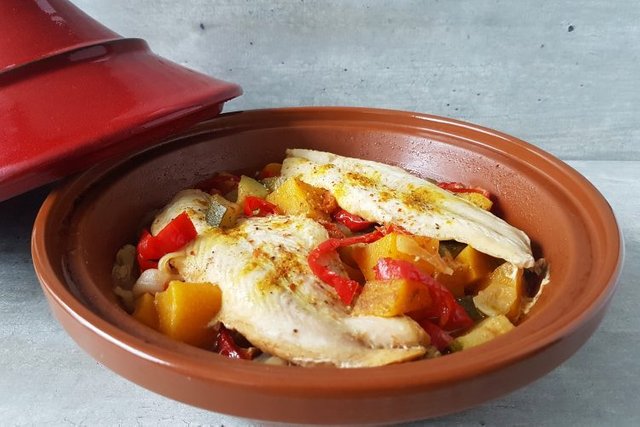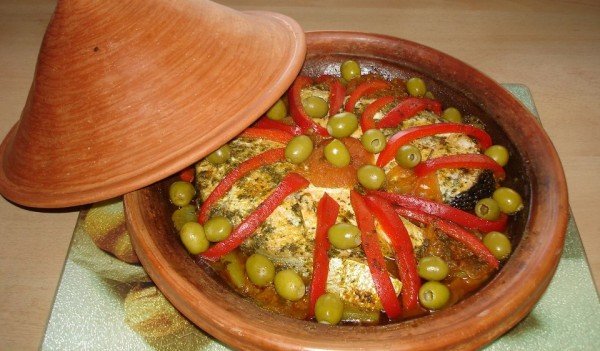Cuisine Traditions Recipes Tajines in Morocco
Tours
A Taste of Morocco Food Tour
Travel Morocco


Other ingredients for a tajine include any product that braises well: fish, quail, pigeon, beef, root vegetables, legumes, even amber and aga wood. Modern recipes in the West include pot roasts, ossobuco, lamb shanks and turkey legs. Seasonings can be traditional Moroccan spices, French, Italian or suited to the dish.
Morocco, perhaps feeling pressure to catch up with Europe, is beginning to use the efficient pressure cooker to make tajines. Recently, European manufacturers have created tajines with heavy cast iron bottoms that can be fired on a stovetop at high heat. This permits browning meat and vegetables before cooking. While the similar Dutch oven and Sac spell (sach) (a cast iron pot with a tight cover) braises most efficiently in the oven, the tajine braises best on the stovetop.
Tajine makers, who want to remain loyal to the original cooking methods but save time, can still cook with saucepans and casseroles, but place them over gas versus a slow fire. Regardless of how you make tajine, you should make it with love and care as this will assure a delicious result. Also, keep in mind that it is difficult to make tajines for large groups because they don’t contain much more than sauce. As a result, a tajine is better prepared for your family or an intimate gathering of friends.
Tajines are a delicious meal if you enjoy exotic ingredients like lamb or chicken marinated in olive oil and garlic. (If you are vegetarian, you can request your tajine to be made without meat during your Moroccan travels). Meats are always first sautéed and then embellished with combinations of marinades including saffron, cumin, crushed red pepper, fresh coriander, parsley, chickpeas, and almonds. To be playful with the dishes, Moroccans sometimes add prunes, ginger, or hard boiled eggs. The standard dish will always include chicken, olives and salted lemons.
Some tricks to get your tajine like those of Moroccan mothers include using cooking butter (you can substitute for olive oil) and large quantities of chopped onions. Warm the onions until they reach their softest state; this will help the tajine sauce taste creamier. Adding a touch of honey is another secret.
Some differences in how tajines vary between regions include details of what spices, fats, and seasonal produce are used. Regardless of where your ingredients come from, one similarity throughout Morocco is that upon preparation, the tajine is commonly ate with couscous or thick wedges of freshly made hot bread used to scoop up the meat and vegetables.
The following are a few of the most popular tajine recipes to recreate at home. For more information about Morocco Cuisine Traditions and Recipes.
Recipe: Beef Tajine with Almonds and Prunes
Ingredients:
3 Lb. beef
4.oz butter
2 tablespoons of olive oil
2 large onions
1 teaspoon salt
1/4 cup sugar
1/2 teaspoon ground black pepper
1 strip lemon peel
1 teaspoon powdered ginger
1 Ib dried prunes
1/2 teaspoon powdered saffron
blanched almonds
3 short cinnamon sticks
fresh water cress or mint
2 tablespoons of olive oil
-Combine the oil and ground spices in a bowl
-cut the beef into cubes, chop onions finely, and mix both into oil and spices. Let stand.
-Sear the meat lightly in butter, add any remaining marinade and enough water to cover
-simmer until meat is tender
-while the meat is cooking, cover the prunes with boiling water. Set aside for 20 minutes
-Drain the prunes and cook them in a small amount of liquid from the meat
-Add the lemon peel, cinnamon sticks, and half the sugar.
-Stir the remaining sugar into the meat
-Arrange the meat, prunes, and their sauce on serving dish
-Boil the remaining liquid from the meat rapidly to reduce it by half
-Pour sauce over the meat and prunes
-Garnish with almonds sautéed in a little butter and with watercress or mint
-Serve with rice or couscous
Recipe: Chicken Tajine with Olives and Preserved Lemons
Rock salt
1 whole large chicken, cut into 8 pieces
1 tablespoon white wine vinegar
5 tablespoons olive oil
1 large bunch fresh cilantro, chopped
1 teaspoon cinnamon
1/2 teaspoon real saffron
Pinch fine salt
1/2 pound onions, chopped
5 cloves garlic, chopped
1 teaspoon cumin
1 teaspoon ground ginger
1 teaspoon paprika
1 teaspoon turmeric
1/4 pound gizzards, optional
1/4 pound chicken liver, optional
1/4 cup mixed olives, pitted
3 small preserved lemons
First rub the rock salt into the chicken pieces and then wash the chicken in the white wine vinegar and water. Leave for 10 minutes. Rinse and dry and place onto a clean plate.
In a large bowl, mix the olive oil, coriander, cinnamon, saffron, fine salt, 1/2 the onions, garlic, cumin, ginger, paprika, turmeric. Mix all these ingredients into the oil and crush the garlic and add a little water to make a paste.
Roll the chicken pieces into the marinade and leave for 10 to 15 minutes.
For cooking, use an earthenware tajine (traditional Moroccan dish) or a deep, heavy bottom casserole dish. Heat the dish up and add 2 tablespoons of olive oil to the hot dish. Drop in the chicken and pour over the excess marinade juices. Add the remaining onions, gizzards, chicken livers, olives, and chopped preserved lemons (no pulp).
Cook on a gas or electric stove for 45 minutes.
Serve with fresh bread

 |
 |
 |
Until next time…
Don’t waste your time online, invest it with steemit.com

Hi! I am a robot. I just upvoted you! I found similar content that readers might be interested in:
http://www.travel-exploration.com/subpage.cfm/Tajine
Downvoting a post can decrease pending rewards and make it less visible. Common reasons:
Submit
Nice post
Downvoting a post can decrease pending rewards and make it less visible. Common reasons:
Submit
thank you!
looking good
follow me
Downvoting a post can decrease pending rewards and make it less visible. Common reasons:
Submit
Congratulations @aquilazack! You have completed some achievement on Steemit and have been rewarded with new badge(s) :
Click on any badge to view your own Board of Honor on SteemitBoard.
For more information about SteemitBoard, click here
If you no longer want to receive notifications, reply to this comment with the word
STOPDownvoting a post can decrease pending rewards and make it less visible. Common reasons:
Submit
cialty from morrocco nice
Downvoting a post can decrease pending rewards and make it less visible. Common reasons:
Submit